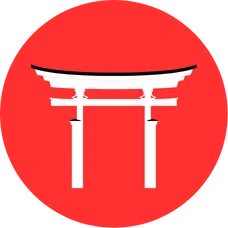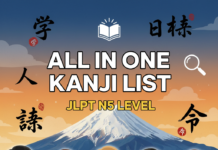Starting your Japanese kanji journey (JLPT Journey) can feel… daunting. It often seems like you’re staring at a wall of complex characters with no clear place to begin.
But here’s the good news: every journey starts with a single step. For the Japanese Language Proficiency Test (JLPT), that first step is the N5 level.
The JLPT N5 is the beginner level, and it requires you to know approximately 100 foundational kanji. Mastering this initial set builds the confidence and the framework you need for all the levels that come after.
We’ve compiled the complete JLPT N5 kanji list right here. But we haven’t just dumped 100+ characters on you. To make it actually useful, we’ve organized them into logical categories (like numbers, time, and people) to help you learn them in context.
Let’s break it down.
How to Use This JLPT Kanji List
Before you dive in, here are two quick tips to get the most out of this list:
- Understand the Readings: Each kanji has two types of readings.
On’yomi (音読み): The “Sino-Japanese” reading, derived from Chinese. It’s often used when kanji are combined into compound words (e.g., in 山火,山 (kazan – volcano)). We’ve written this in Katakana.
Kun’yomi (訓読み): The “native Japanese” reading. It’s often used when the kanji stands alone or is paired with hiragana (okurigana) (e.g., 山 (yama – mountain)). We’ve written this in Hiragana.
- Don’t Just Memorize the List:
Rote memorization is a path to frustration. The best way to learn kanji is to learn them in vocabulary words. See the kanji 人 (hito) and learn the word 人 (hito – person) and 日本人 (nihonjin – Japanese person) at the same time.
The Complete JLPT N5 Kanji List
Numbers & Money
| Kanji | Meaning | On’yomi (Katakana) | Kun’yomi (Hiragana) |
| 一 | One | イチ | ひと(つ) |
| 二 | Two | ニ | ふた(つ) |
| 三 | Three | サン | み(っつ) |
| 四 | Four | シ | よん, よ(っつ) |
| 五 | Five | ゴ | いつ(つ) |
| 六 | Six | ロク | む(っつ) |
| 七 | Seven | シチ | なな(つ) |
| 八 | Eight | ハチ | や(っつ) |
| 九 | Nine | キュウ, ク | ここの(つ) |
| 十 | Ten | ジュウ | とお |
| 百 | Hundred | ヒャク | – |
| 千 | Thousand | セン | ち |
| 万 | Ten Thousand | マン | – |
| 円 | Yen / Circle | エン | まる(い) |
Time, Days & Calendar
| Kanji | Meaning | On’yomi (Katakana) | Kun’yomi (Hiragana) |
| 日 | Day, Sun | ニチ, ジツ | ひ, -び, -か |
| 月 | Month, Moon | ゲツ, ガツ | つき |
| 火 | Fire | カ | ひ, -び |
| 水 | Water | スイ | みず |
| 木 | Tree, Wood | モク, ボク | き, こ- |
| 金 | Gold, Money | キン | かね |
| 土 | Earth, Soil | ド, ト | つち |
| 年 | Year | ネン | とし |
| 時 | Time, Hour | ジ | とき |
| 分 | Minute, Part | フン, プン | わ(かる) |
| 今 | Now | コン | いま |
| 先 | Before, Ahead | セン | さき |
| 来 | To Come | ライ | く(る) |
| 半 | Half | ハン | なか(ば) |
| 毎 | Every | マイ | – |
| 何 | What | カ | なに, なん |
People & Family
| Kanji | Meaning | On’yomi (Katakana) | Kun’yomi (Hiragana) |
| 人 | Person | ジン, ニン | ひと |
| 男 | Man, Male | ダン, ナン | おとこ |
| 女 | Woman, Female | ジョ | おんな |
| 子 | Child | シ | こ |
| 父 | Father | フ | ちち |
| 母 | Mother | ボ | はは |
| 友 | Friend | ユウ | とも |
| 先 | Teacher | セン | さき |
| 生 | Life, Birth | セイ, ショウ | い(きる), う(まれる) |
Nature
| Kanji | Meaning | On’yomi (Katakana) | Kun’yomi (Hiragana) |
| 山 | Mountain | サン | やま |
| 川 | River | セン | かわ |
| 田 | Rice Field | デン | た |
| 石 | Stone | セキ | いし |
| 花 | Flower | カ | はな |
| 空 | Sky, Empty | クウ | そら, あ(く) |
| 雨 | Rain | ウ | あめ |
| 天 | Heaven, Sky | テン | あま |
Directions & Location
| Kanji | Meaning | On’yomi (Katakana) | Kun’yomi (Hiragana) |
| 上 | Up, Above | ジョウ | うえ, あ(がる) |
| 下 | Down, Below | カ, ゲ | した, さ(がる) |
| 左 | Left | サ | ひだり |
| 右 | Right | ウ, ユウ | みぎ |
| 中 | Inside, Middle | チュウ | なか |
| 外 | Outside | ガイ, ゲ | そと |
| 前 | Before, Front | ゼン | まえ |
| 後 | After, Back | ゴ, コウ | うし(ろ), あと |
| 東 | East | トウ | ひがし |
| 西 | West | セイ, サイ | にし |
| 南 | South | ナン | みなみ |
| 北 | North | ホク | きた |
| 近 | Near | キン | ちか(い) |
| 遠 | Far | エン | とお(い) |
Basic Verbs (Part 1)
| Kanji | Meaning | On’yomi (Katakana) | Kun’yomi (Hiragana) |
| 行 | To Go | コウ, ギョウ | い(く) |
| 来 | To Come | ライ | く(る), き(ます) |
| 帰 | To Return | キ | かえ(る) |
| 食 | To Eat | ショク | た(べる) |
| 飲 | To Drink | イン | の(む) |
| 見 | To See | ケン | み(る) |
| 聞 | To Hear, Listen | ブン | き(く) |
| 読 | To Read | ドク | よ(む) |
| 書 | To Write | ショ | か(く) |
| 話 | To Speak | ワ | はな(す) |
Basic Verbs (Part 2)
| Kanji | Meaning | On’yomi (Katakana) | Kun’yomi (Hiragana) |
| 買 | To Buy | バイ | か(う) |
| 売 | To Sell | バイ | う(る) |
| 立 | To Stand | リツ | た(つ) |
| 座 | To Sit | ザ | すわ(る) |
| 入 | To Enter | ニュウ | はい(る), い(る) |
| 出 | To Go Out | シュツ | で(る), だ(す) |
| 会 | To Meet | カイ | あ(う) |
| 休 | To Rest | キュウ | やす(む) |
| 言 | To Say | ゲン | い(う) |
Basic Adjectives
| Kanji | Meaning | On’yomi (Katakana) | Kun’yomi (Hiragana) |
| 大 | Big | ダイ, タイ | おお(きい) |
| 小 | Small | ショウ | ちい(さい) |
| 高 | High, Expensive | コウ | たか(い) |
| 安 | Cheap, Safe | アン | やす(い) |
| 新 | New | シン | あたら(しい) |
| 古 | Old | コ | ふる(い) |
| 多 | Many, Much | タ | おお(い) |
| 少 | Few, Little | ショウ | すく(ない), すこ(し) |
| 長 | Long | チョウ | なが(い) |
| 白 | White | ハク | しろ(い) |
| 黒 | Black | コク | くろ(い) |
| 赤 | Red | セキ | あか(い) |
| 青 | Blue | セイ | あお(い) |
School & Objects
| Kanji | Meaning | On’yomi (Katakana) | Kun’yomi (Hiragana) |
| 学 | Study, Learn | ガク | まな(ぶ) |
| 校 | School | コウ | – |
| 本 | Book, Origin | ホン | もと |
| 名 | Name | メイ | な |
| 語 | Word, Language | ゴ | かた(る) |
| 電 | Electricity | デン | – |
| 車 | Car, Wheel | シャ | くるま |
| 駅 | Station | エキ | – |
Other Essentials
| Kanji | Meaning | On’yomi (Katakana) | Kun’yomi (Hiragana) |
| 気 | Spirit, Air | キ, ケ | – |
| 店 | Shop | テン | みせ |
| 会 | Meet, Society | カイ | あ(う) |
| 社 | Company, Shrine | シャ | やしろ |
| 国 | Country | コク | くに |
| 道 | Road, Way | ドウ | みち |
A List is Just a List. How to Actually Learn N5 Kanji.
You have the list. Great. Now what?
Simply reading this page 50 times won’t work. Your brain needs context and active recall. Here’s how you can actually learn these characters.
- Use a Spaced Repetition System (SRS)
This is non-negotiable. An SRS is a flashcard system that quizzes you on a character right before you’re about to forget it. It’s the most efficient way to drill information into your long-term memory.
Tools: Anki (the gold standard, but steep learning curve), WaniKani (gamified, excellent for kanji).
- Learn with Vocabulary
I’ll say it again: Do not learn kanji in isolation. It’s a waste of time. Why?
Bad: Memorizing “学 = GAKU, mana(bu), study.”
Good: Learning the words 学校 (gakkou – school) and 学生 (gakusei – student).
When you learn the vocabulary, you learn the correct reading and the meaning in a real-world context.
You’ve Got This
That’s the complete foundation. Mastering these ~100 kanji is your first major victory in Japanese. Take it one step at a time, focus on vocabulary, and be consistent. Before you know it, these characters will be as familiar as “A, B, C.”
When you’re ready, you can move on to the [JLPT N4 Kanji List]!

